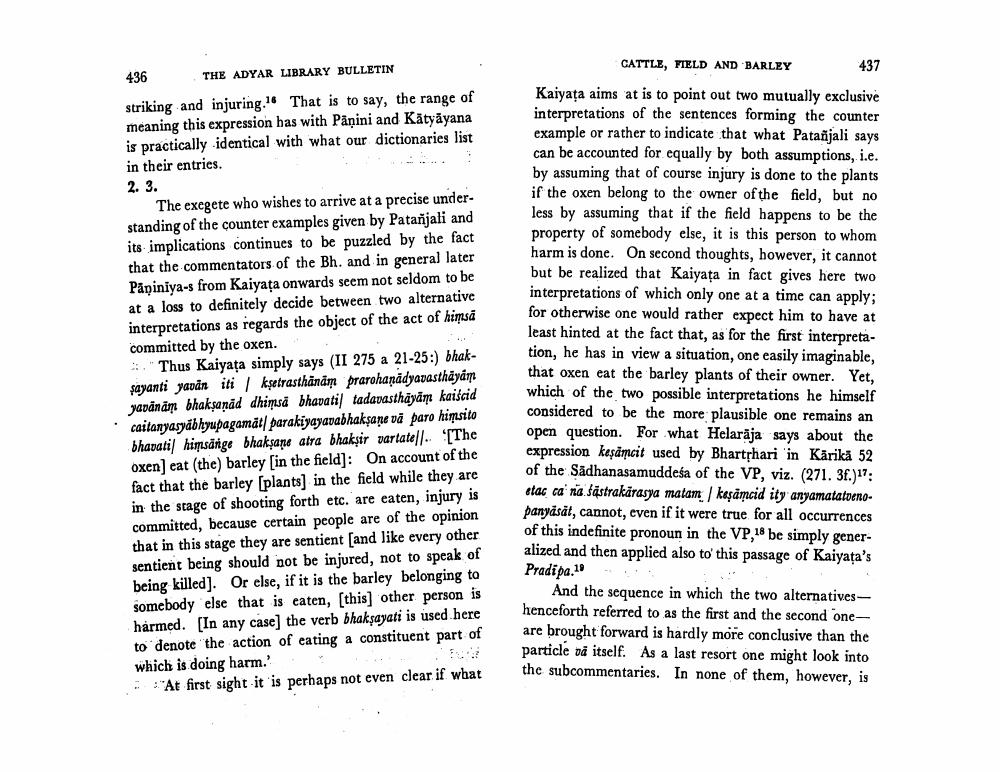Book Title: Cattle Field And Barley Note On Mahabhasya Author(s): A Wezler Publisher: A Wezler View full book textPage 4
________________ 436 THE ADYAR LIBRARY BULLETIN CATTLE, FIELD AND BARLEY 437 striking and injuring. That is to say, the range of meaning this expression has with Påņini and Katyāyana is practically identical with what our dictionaries list in their entries. 2. 3. The exegete who wishes to arrive at a precise understanding of the counter examples given by Patañjali and its implications continues to be puzzled by the fact that the commentators of the Bh. and in general later Paniniya-s from Kaiyata onwards seem not seldom to be at a loss to definitely decide between two alternative interpretations as regards the object of the act of himsa committed by the oxen. 3. Thus Kaiyata simply says (II 275 a 21-25:) bhaksayanti yavån iti / kşetrasthanam prarohanadyavasthayam yapanām bhaksanād dhimsa bhavati tadavasthayam kaišcid caitanyasyabhyupagamät parakiyayavabhakşane vă paro hirsito bhavati hirrsänge bhakşane atra bhakşir vartatell. [The oxen) eat (the) barley [in the field]: On account of the fact that the barley (plants) in the field while they are in the stage of shooting forth etc. are eaten, injury is committed, because certain people are of the opinion that in this stage they are sentient (and like every other sentient being should not be injured, not to speak of being killed). Or else, if it is the barley belonging to somebody else that is eaten, [this] other person is hármed. [In any case) the verb bhakşayati is used here to denote the action of eating a constituent part of which is doing harm.? "At first sight it is perhaps not even clear if what Kaiyața aims at is to point out two mutually exclusive interpretations of the sentences forming the counter example or rather to indicate that what Patañjali says can be accounted for equally by both assumptions, i.e. by assuming that of course injury is done to the plants if the oxen belong to the owner of the field, but no less by assuming that if the field happens to be the property of somebody else, it is this person to whom harm is done. On second thoughts, however, it cannot but be realized that Kaiyața in fact gives here two interpretations of which only one at a time can apply; for otherwise one would rather expect him to have at least hinted at the fact that, as for the first interpretation, he has in view a situation, one easily imaginable, that oxen eat the barley plants of their owner. Yet, which of the two possible interpretations he himself considered to be the more plausible one remains an open question. For what Helaraja says about the expression kaşámcit used by Bharthari 'in Kårika 52 of the Sadhanasamuddeśa of the VP, viz. (271. 3f.): stac ca na fästrakärasya matam kasamcid ity anyamatatvenopanyasát, cannot, even if it were true for all occurrences of this indefinite pronoun in the VP, be simply generalized and then applied also to this passage of Kaiyata's Pradipa.10 And the sequence in which the two alternatives - henceforth referred to as the first and the second oneare brought forward is hardly more conclusive than the particle va itself. As a last resort one might look into the subcommentaries. In none of them, however, isPage Navigation
1 2 3 4 5 6 7 8 9 10 11 12 13 14 15 16 17 18 19 20 21 22 23 24
